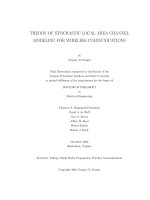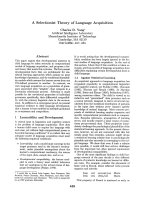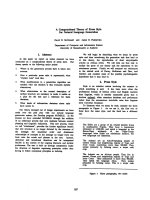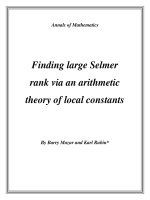THEORY OF MACHINES (RME602)
Bạn đang xem bản rút gọn của tài liệu. Xem và tải ngay bản đầy đủ của tài liệu tại đây (1.13 MB, 10 trang )
<span class="text_page_counter">Trang 1</span><div class="page_container" data-page="1">
<b>SHAMBHUNATH INSTITUTE OF ENGINEERING AND TECHNOLOGY </b>
<b>Theory of machines (RME602) </b>
<b>B. Tech. (VI-SEMESTER)</b>
<b>FIRST SESSIONAL EXAMINATION, EVEN SEMESTER, (2019-2020) </b>
<b>Branch: Mechanical Engineering</b>
<b>Time –1hr 30 min Maximum Marks – 30 SECTION – A </b>
<b>a. </b>
Define pressure angle.
<i><b>Pressure angle or angle of obliquity</b></i>. It is the angle between the common normal to two teeth at
the point of contact and the common tangent at the pitch point.
<b>1 2 1 </b>
<b>b. </b>
What are the advantages of gear drive over other drive?
<i><b>Advantages </b></i>
<b>1. </b>It transmits exact velocity ratio.
<b>2. </b>It may be used to transmit large power.
<b>3. </b>It has high efficiency.
<b>4. </b>It has reliable service.
<b>5. </b>It has compact layout.
<b>c. </b>
Define contact ratio.
The contact ratio or the number of pairs of teeth in contact is defined as the <b>ratio of the length of the arc of contact to the circular pitch. </b>
<b>d. </b>
What is the function of flywheel?
<i><b>a flywheel controls the speed variations caused by the fluctuation of the engine turning moment during each cycle of operation.</b></i>
<b>e. </b>
Define the term coefficient of fluctuation of speed.
The ratio of the maximum fluctuation of speed to the mean speed is called the <i><b>coefficient of </b></i>
</div><span class="text_page_counter">Trang 2</span><div class="page_container" data-page="2">From Fig. 12.11, we find that radius of the base circle of pinion,
<b>b. </b>
<b>State and prove the law of gearing. </b>
Consider the portions of the two teeth, one on the wheel 1 (or pinion) and the other on the
<i>wheel 2, as shown by thick line curves in Fig. 12.6. Let the two teeth come in contact at point Q, and the wheels rotate in the directions as shown in the figure. Let T T be the common tangent and MN be the common normal to the curves at the point of contact Q. From the centres O</i><small>1 </small><i>and O</i><small>2 </small>,
<i>draw O</i><small>1</small><i>M and O</i><small>2</small><i>N perpendicular to MN. A little consideration will show that the point Q moves in the direction QC, when considered as a point on wheel 1, and in the direction QD when considered as a point on wheel 2. Let v</i><small>1 </small><i>and v</i><small>2 </small><i>be the velocities of the point Q on the wheels 1 and 2 </i>
respectively. If the teeth are to remain in contact, then the components of these velocities along the
<i>common normal MN must be equal. </i>
</div><span class="text_page_counter">Trang 3</span><div class="page_container" data-page="3">From above, we see that the angular velocity ratio is inversely proportional to the ratio of the
<i>distances of the point P from the centres O</i><small>1 </small><i>and O</i><small>2</small>, or the common normal to the two surfaces at
<i>the point of contact Q intersects the line of centres at point P which divides the centre distance </i>
inversely as the ratio of angular velocities. Therefore in order to have a constant angular velocity
<i>ratio for all positions of the wheels, the point P must be the fixed point (called pitch point) for the </i>
two wheels. In other words, <i><b>the commonnormal at the point of contact between a pair of teeth must always pass through the pitch point.</b></i> This is the fundamental condition which must be satisfied while designing the profiles for the teeth of gear wheels. It is also known as <i><b>law of gearing</b></i>
<b>c. </b>
<b>Explain the working of epicyclic gear train with sketch.also give its applications. </b>
<b>Epicyclic Gear Train </b>
A simple epicyclic gear train is shown in Fig.
<i>where a gear A and the arm C have a common axis at O</i><small>1 </small><i>about which they can rotate. The gear B meshes with gear A and has its axis on the arm at O</i><small>2</small><i>, about which the gear B can rotate. If the arm is fixed, the gear train is simple and gear A can drive gear B or <b>vice- versa</b>, but if gear A is fixed and the arm is rotated about the axis of gear A (i.e. O</i><small>1</small><i>), then the gear B is forced to rotate </i>
<i><b>upon </b></i>and <i><b>around </b>gear A. Such a motion is called </i><b>epicyclic </b>and the gear trains arranged in such a manner that one or more of their members move upon and around another member are known as
<i><b>epicyclic gear trains </b></i>(<i><b>epi. </b></i>means upon and <i><b>cyclic</b></i> means around). The epicyclic gear trains may be
<i><b>simple </b></i>or <i><b>compound.</b></i> The epicyclic gear trains are useful for transmitting high velocity ratios with gears of moderate size in a comparatively lesser space. The epicyclic gear trains are used in the back gear of lathe, differential gears of the automobiles, hoists, pulley blocks, wrist watches etc.
Explain the turning moment diagram for a four stroke internal combustion engine.
<b>Turning Moment Diagram for a Four Stroke Cycle Internal Combustion Engine </b>
A turning moment diagram for a four stroke cycle internal combustion engine is shown in Fig. . We know that in a four stroke cycle internal combustion engine, there is one working
</div><span class="text_page_counter">Trang 4</span><div class="page_container" data-page="4">The turning moment diagram for a multi-cylinder engine has been drawn to a scale of 1 mm to 500 N-m torque and 1 mm to 6° of crank displacement. The intercepted areas between output torque curve and mean resistance line taken in order from one end, in sq. mm are – 30, + 410, – 280, + 320, – 330, + 250, – 360, + 280, – 260 sq. mm, when the engine is running at 800 r.p.m.
The engine has a stroke of 300 mm and the fluctuation of speed is not to exceed ± 2% of the mean speed. Determine a suitable diameter and cross-section of the flywheel rim for a limiting value of the safe centrifugal stress of 7 MPa. The material density may be assumed as 7200 kg/m<sup>3</sup>. The width of the rim is to be 5 times the thickness.
</div><span class="text_page_counter">Trang 5</span><div class="page_container" data-page="5">The turning moment diagram for a multicylinder engine has been drawn to a scale 1 mm = 600 N-m vertically and 1 mm = 3° horizontally. The intercepted areas between the output torque curve and the mean resistance line, taken in order from one end, are as follows : +
</div><span class="text_page_counter">Trang 6</span><div class="page_container" data-page="6">Since the total fluctuation of speed is not to exceed 1.5% of the mean speed, therefore
<b>4. Attempt any ONE part of the following : (1*5 = 5) </b>
A pinion having 30 teeth drives a gear having 80 teeth. The profile of the gears is involute with 20° pressure angle, 12 mm module and 10 mm addendum. Find the length of path of
</div><span class="text_page_counter">Trang 7</span><div class="page_container" data-page="7"><b>b. </b>
Two involute gears of 20° pressure angle are in mesh. The number of teeth
on pinion is 20 and the gear ratio is 2. If the pitch expressed in module is 5 mm and the pitch line speed is 1.2 m/s, assuming addendum as standard and equal to one module, find :
<b>1-</b>The angle turned through by pinion when one pair of teeth is in mesh .
<b>2-</b>The maximum velocity of sliding.
<b>5 2 </b>
<b>3 </b>
</div><span class="text_page_counter">Trang 8</span><div class="page_container" data-page="8"><b>5. Attempt any ONE part of the following : (1*5 = 5) </b>
In a reverted epicyclic gear train, the arm A carries two gears B and C and a
compound gear D - E. The gear B meshes with gear E and the gear C meshes with gear D. The number of teeth on gears B, C and D are 75, 30 and 90 respectively. Find the speed and direction of gear C when gear B is fixed and the arm A makes 100 r.p.m clockwise.
</div><span class="text_page_counter">Trang 9</span><div class="page_container" data-page="9">








